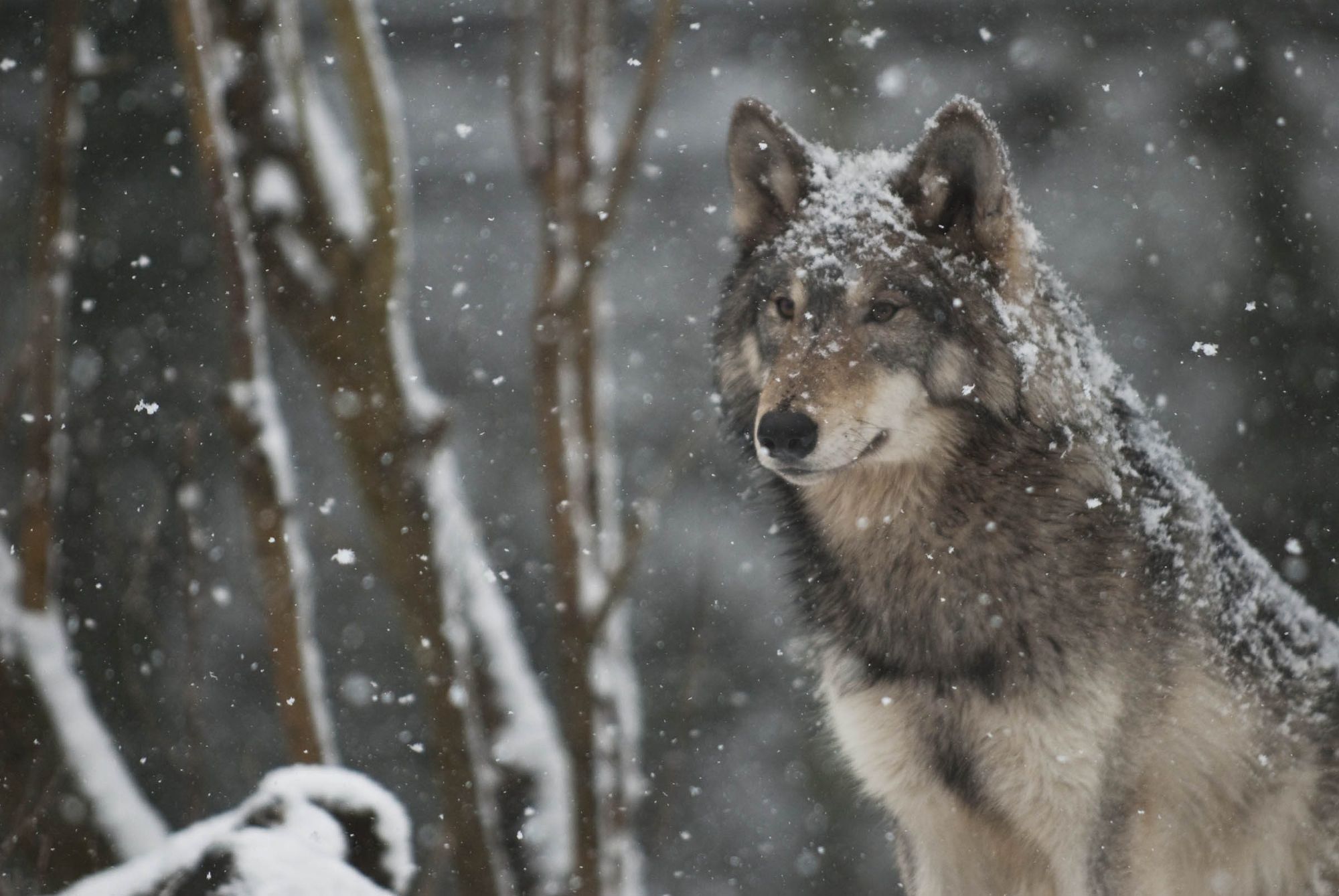
Gray Wolf
The Gray Wolf is a cunning and noble predator. Legendary for its hunting prowess, it provokes wonder, fear and awe.
The Gray Wolf (Canis lupus) is known for its fierce appearance, excellent hunting ability, and pack behavior. With a howl that can travel great distances through the wilderness, a beautiful coat of fur, and the ability to adapt to a myriad of environments, the wolf is also a creature that has played a major role in many mythologies and fairy tales. American Expedition is proud to present Information, Interesting Facts & Trivia, Photos & Artwork, and Habitat Information for Gray Wolves.
Dim wolves extend in shading from grizzled dark or dark to all-white. As the precursor of the residential puppy, the dark wolf takes after German shepherds or malamutes. Despite the fact that they once almost vanished from the lower 48 states, today wolves have come back to the Great Lakes, northern Rockies and Southwestern United States.
Wolves assume a key part in keeping biological systems sound. They help hold deer and elk populaces under control, which can profit numerous other plant and creature species. The corpses of their prey additionally help to redistribute supplements and give sustenance to other untamed life species, similar to wild bears and scroungers. Researchers are simply starting to completely comprehend the positive progressively outstretching influences that wolves have on biological communities.
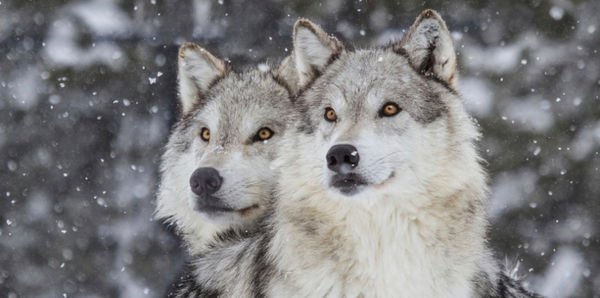
Eating regimen
Wolves eat ungulates, or expansive hoofed vertebrates, similar to elk, deer, moose and caribou, and in addition beaver, rabbits and other little prey. Wolves are additionally scroungers and frequently eat creatures that have passed on because of different causes.
Populace
Did You Know?
Wolves have remarkable yells, similar to fingerprints, that researchers (and other pack individuals) can use to disclose to them separated.
There are an expected 7,000 to 11,200 dark two-timers, in the Great Lakes district and 1,675 in the Northern Rockies.
Territory and RANGE
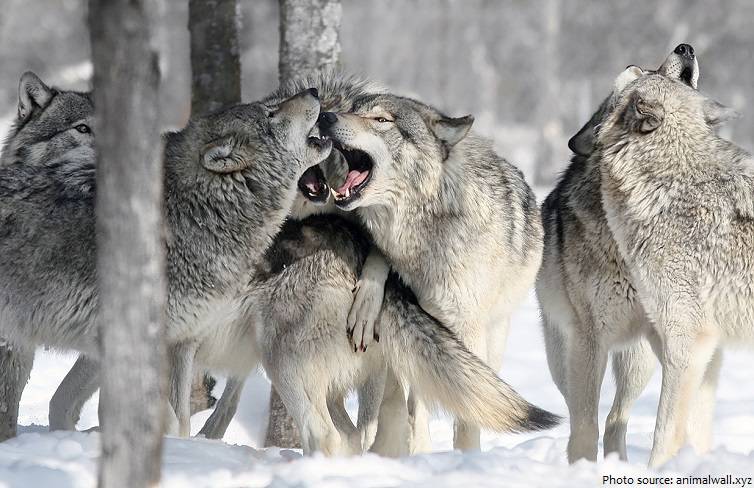
Dark wolves were once basic all through all of North America, yet were killed in many zones of the United States by the mid 1930s. Today, their range has been decreased to Canada, Alaska, the Great Lakes, northern Rockies and Pacific Northwest. On account of the reintroduction of posers, National Park is a standout amongst the most supported spots to see and hear scoundrels living space. Wolves require huge regions of coterminous living space that can incorporate timberlands and precipitous landscape, and Mexican dark wolves can flourish in forsake and brush in the southwest. Appropriate living space must have adequate access to prey, insurance from over the top mistreatment, and zones for denning and taking asylum.
Did You Know?
The alpha female and alpha male wolves of a pack typically mate forever.
Conduct
Wolves live, travel and chase in packs of 7 to 8 creatures by and large. Packs incorporate the mother and father wolves (called the alphas), their pups and more established posterity. The alpha female and male are regularly the pack pioneers that track and chase prey, pick lair destinations and set up the pack's region. Wolves create solid social bonds inside their packs.
Wolves have an unpredictable correspondence framework going from barks and whimpers to snarls and cries. While they don't really cry at the moon, they are more dynamic at day break and nightfall, and they do wail increasingly when it's lighter during the evening, which happens all the more frequently when the moon is full.
Propagation
Reproducing season happens once every year late January through March. Pups are conceived visually impaired and vulnerable. The pack nurtures the pups until the point when they completely develop at around 10 months of age when they can chase without anyone else. Once developed, youthful wolves may scatter. Scattering wolves have been known to fly out 50 to 500 miles.
Mating Season: January or February.
Growth: 63 days
Litter size: 4-7 pups
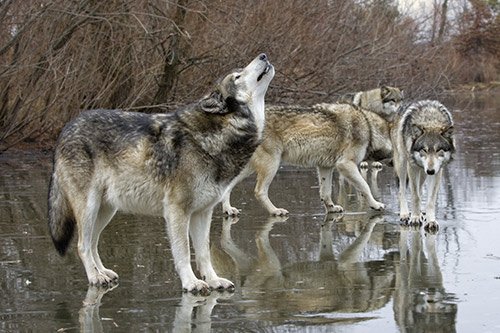
COMMON NAME: Gray Wolf
SCIENTIFIC NAME: Canis lupus
TYPE: Mammals
DIET: Carnivores
GROUP NAME: Pack
AVERAGE LIFE SPAN IN THE WILD: 6 to 8 years
SIZE: Head and body, 36 to 63 in; tail, 13 to 20 in
WEIGHT: 40 to 175 lbs
SIZE RELATIVE TO A 6-FT MAN:
ABOUT THE GRAY WOLF
Wolves are legendary because of their spine-tingling howl, which they use to communicate. A lone wolf howls to attract the attention of his pack, while communal howls may send territorial messages from one pack to another. Some howls are confrontational. Much like barking domestic dogs, wolves may simply begin howling because a nearby wolf has already begun.
Population and Conservation
Wolves are the largest members of the dog family. Adaptable gray wolves are by far the most common and were once found all over the Northern Hemisphere. But wolves and humans have a long adversarial history. Though they almost never attack humans, wolves are considered one of the animal world's most fearsome natural villains. They do attack domestic animals, and countless wolves have been shot, trapped, and poisoned because of this tendency.
In the lower 48 states, gray wolves were hunted to near extinction, though some populations survived and others have since been reintroduced. Few gray wolves survive in Europe, though many live in Alaska, Canada, and Asia.
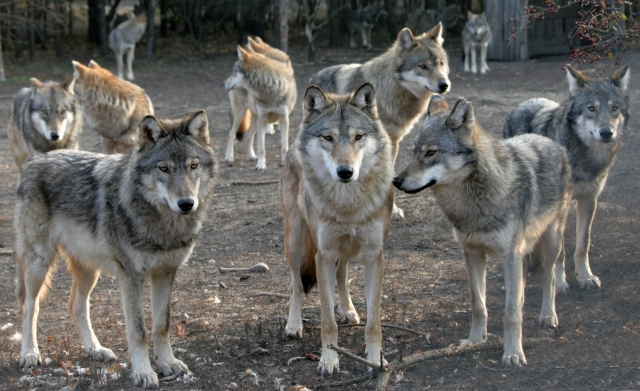
Wolf Pack Behavior
Wolves live and hunt in packs of around six to ten animals. They are known to roam large distances, perhaps 12 miles in a single day. These social animals cooperate on their preferred prey—large animals such as deer, elk, and moose. When they are successful, wolves do not eat in moderation. A single animal can consume 20 pounds of meat at a sitting. Wolves also eat smaller mammals, birds, fish, lizards, snakes, and fruit.
Wolfpacks are established according to a strict hierarchy, with a dominant male at the top and his mate not far behind. Usually this male and female are the only animals of the pack to breed. All of a pack's adults help to care for young pups by bringing them food and watching them while others hunt.
Gray Wolf Information
Gray wolves, also known as "timber wolves" or "common wolves," are the largest members of the wild canid family. The average measures between 3.5 and 5.5 feet long, and weighs approximately 80 pounds. Despite their name, a wolf’s fur can range in color from almost pure white to black. The most common shade is tawny brown.
Gray wolves are social animals, and form packs of up to 12 members, usually consisting of a nuclear family. Wolf packs contain a dominant, or “Alpha” male and female, their offspring, and other wolves not related to the dominant pair. All of the wolves have a rank that determines their roles and hierarchy in the pack. Wolves are well known for their distinct sound: the howl. This unique noise can travel for several miles. Wolves howl for a number of reasons, including communication with other packs and with their own pack over long distances, to gather a pack for a hunt, to warn off intruders, or to attract mates.
Artwork of a wolf howling at the moon.

Wolf mating season is from January to February and is usually limited to the alpha pair, although males will sometimes mate with subordinate females as well. The alpha female will have litters of up to 6 pups each year. During their first months, pups are completely dependent on their mother's milk. They are gradually weaned so that when they are seven months old, they are ready to start hunting with the adults. Raising the wolf pups is a responsibility shared by all members of the pack, and young wolves will typically stay in their pack for two to three years. Eventually, the young wolves will leave to join other packs, or find a mate and form their own packs. A wolf's average life span is 6-8 years, although the record wolf life span is around 20 years.
Gray wolves once had one of the largest ranges of any species, surpassed only by humans. It spanned throughout Eurasia, North America, and Africa, covering the entire continental northern hemisphere. Currently, the gray wolf inhabits a reduced portion of its range, largely due to human activity and habitat destruction. Data suggests that there were up to at least 400,000 wolves in the U.S., but presently there are only about 9,000 in the United States.
Gray Wolf Facts & Trivia
Wolves are typically the apex predators in their range, challenged only by tigers and humans.
The female alpha wolf makes a den and stays with her cubs for several weeks, while other wolves from the pack bring her food. After several weeks go by, the female alpha emerges for a short while to find her own food, but returns to the den immediately after.
Wolves are monogamous, they stay with the same mate for life.
The gestation period for a wolf is only about 63 days.
A wolf pup’s eyes open 15 days after being born.
Gray wolves develop strong bonds between the fellow wolves in the pack.
In colder regions, wolves can reduce the flow of blood near their skin to conserve warmth.
Wolves have very dense outer fur in the winter, with shorter underfur and long, coarse guardhairs. They will shed most of their underfur and some guard hairs in the spring, and then grow the fur back in the autumn.
Wolves usually have longer hair on their back front quarters and neck, which almost form a crest.
A wolves winter fur is especially well adapted to the cold, and can help it comfortably withstand temperatures of up to -40° when curled up. Wolf fur does not collect ice when warm breath is condensed against it.
Female wolves typically have smoother fur than males.
As a wolf ages, the hair on the tip of the tail, nose, and forehead may turn white.
The gray wolf's sense of smell is relatively weak compared to some hunting dog breeds; however their auditory perception is sharp enough to hear the fall of leaves.
Wolves primarily use their hunting energy to target large hoofed animals like deer, moose, bison, mountain goats, sheep, elk, and caribou. Despite the wolves' extremely acute hunting skills, most of the animals they stalk eventually escape. Wolves are also opportunistic hunters, and will target small prey if it is available to them.
Wolves will chase their prey if it flees, and are good sprinters, capable of hitting speeds of up to 38 miles per hour. They are also highly capable distance runners, and have been known to chase deer up to 12 miles.
Wolves can eat as much as 22 pounds of meat in one sitting. Eating large amounts after a big kill in necessary because their hunts take so much effort and are not often successful.
Wolves can go longer than a week without eating, with one known case of a wolf surviving for 17 days without food.
Wolves have 42 highly specialized teeth. Their canines, or "fangs," measure around 2-1/2" long, and they also have large molars for crushing and grinding bones. The jaws of a wolf are extremely powerful, and the wolf has a biting capacity of between 1,000 and 1,500 pounds per square inch.
Artwork of a running gray wolf.
.
Gray wolves were hunted nearly to extinction in the continental U.S. due to the threats they posed to human safety and livestock. Today, their population is mainly confined to northern regions with sparse human populations and areas to which they have been reintroduced, like Yellowstone.
Habitat
Wolves can thrive in a variety of environments from the tundra to the woods, forests, grasslands, or even deserts. Wolves require large areas capable of supporting stable populations of their prey. The range of a wolf pack typically varies from 80 to 300 miles, depending on the number of prey species inhabiting the region. In extreme northern regions, territories can cover over 1,000 square miles.
Artwork of a pack of gray wolves
What Do Wolves Eat?
Wolves primarily use their hunting energy to target large hoofed animals like deer, moose, bison, mountain goats, sheep, elk, and caribou. Despite the wolves' extremely acute hunting skills, most of the animals they stalk eventually escape. Wolves are also opportunistic hunters, and will target small prey if it is available to them, such as rabbits, snakes, mice, birds, fish, and beavers.
Wolves can go longer than a week without eating, with one known case of a wolf surviving for 17 days without food.
Wolves have 42 highly specialized teeth. Their canines, or "fangs," measure around 2-1/2" long, and they also have large molars for crushing and grinding bones. The jaws of a wolf are extremely powerful, and the wolf has a biting capacity of between 1,000 and 1,500 pounds per square inch.
Wolves & People
For Native Americans, wolves were a special creature that deserved utmost respect. They were known as a guide to the spiritual world, and therefore well respected. Native Americans admired the courage and patience of wolves, and tried to imitate them. Some tribes gave all of the credit of their hunting ability to the wolves, saying they learned to hunt by watching the wolves.
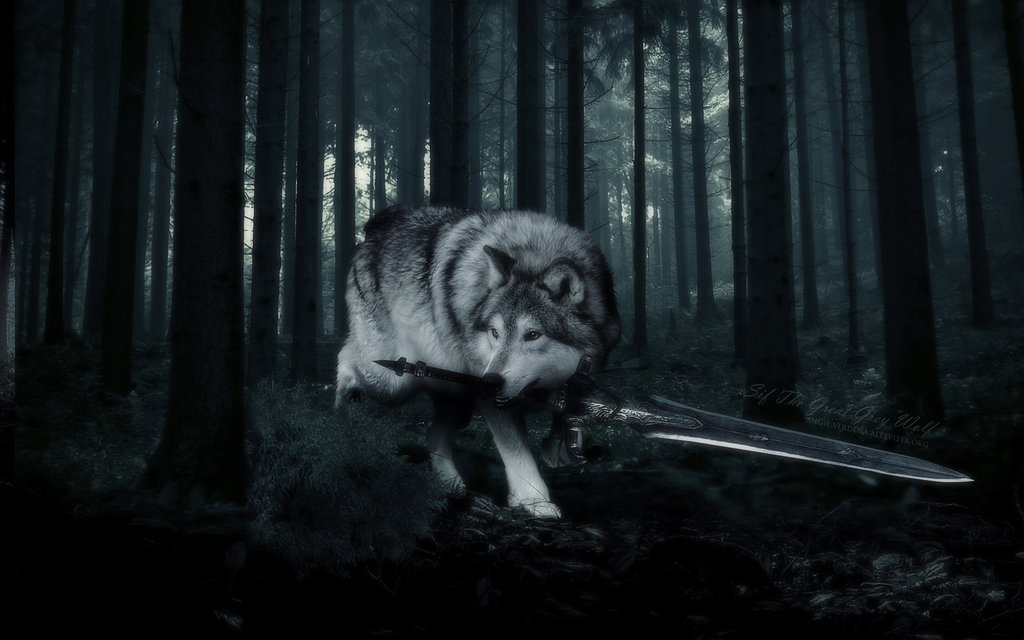
Native Americans felt that they also had a lot in common with the wolves. Both cared for their family and defended them from danger, both hunted for a living, and both were very social. As a result of all of these similarities, native Americans felt a deep and inseparable bond with the wolves.
Hi! I am a robot. I just upvoted you! I found similar content that readers might be interested in:
https://americanexpedition.us/learn-about-wildlife/gray-wolf-facts-information/
Downvoting a post can decrease pending rewards and make it less visible. Common reasons:
Submit